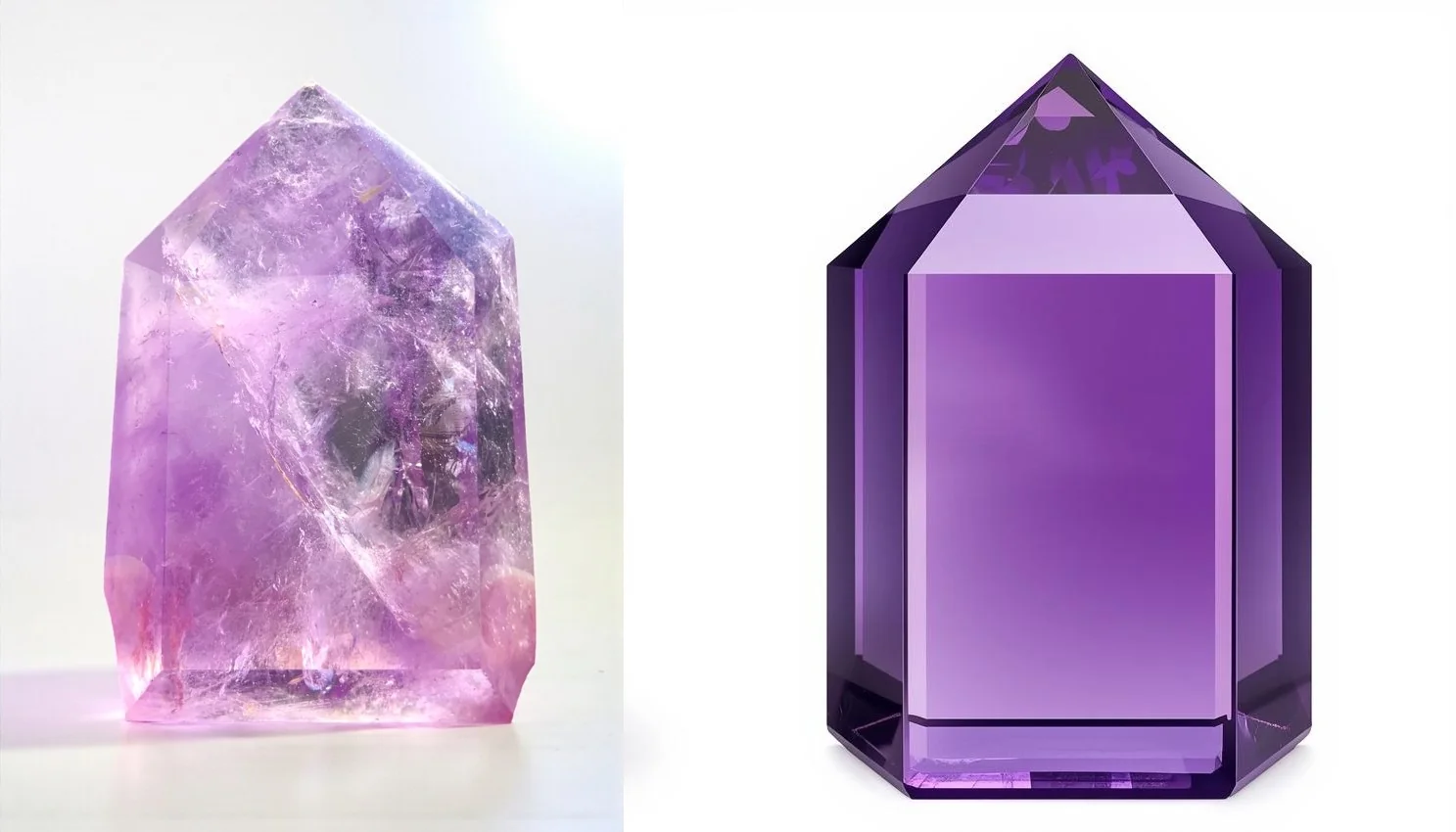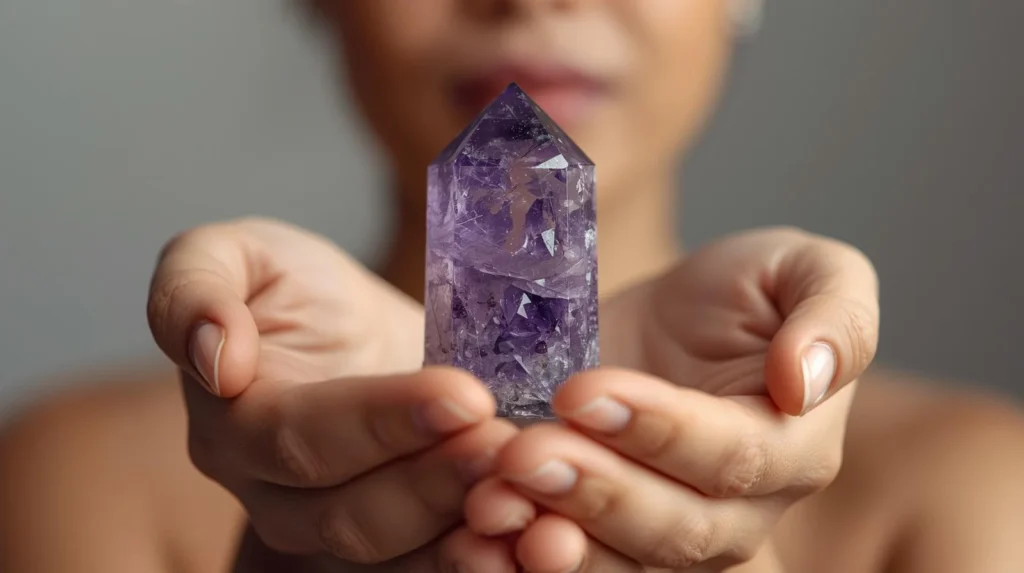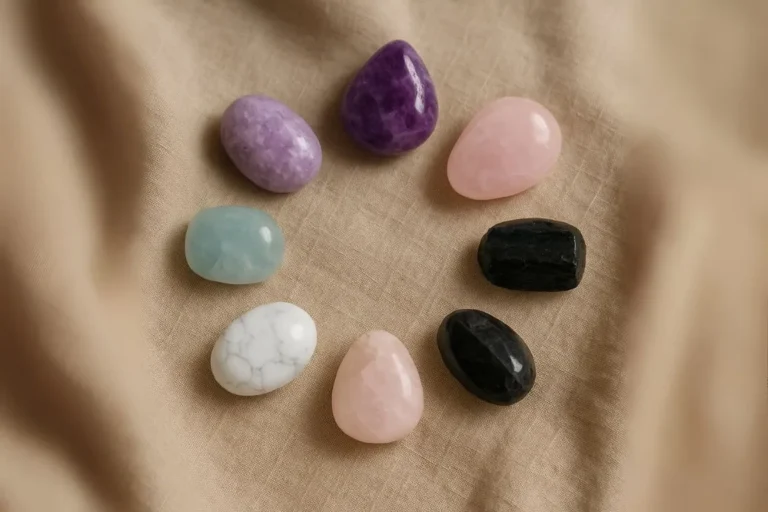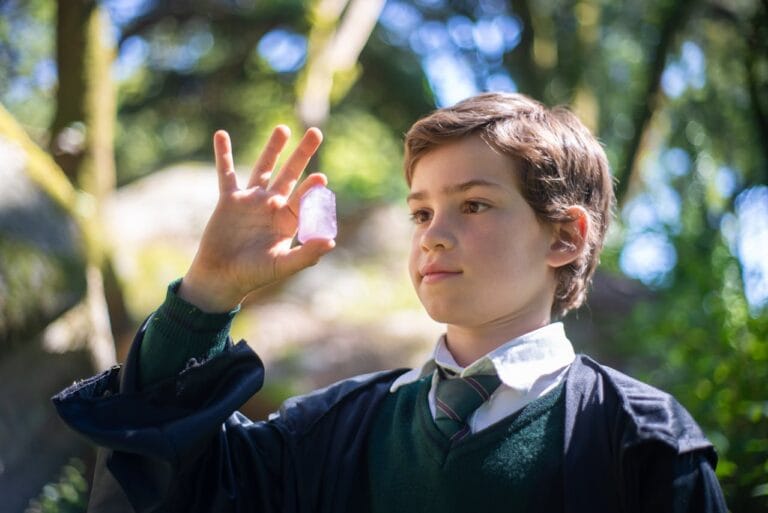How Can You Tell if Amethyst Is Real? 5 Simple Tests Anyone Can Do

Quick Answer
How can you tell if amethyst is real?
Real amethyst shows natural color variations (not uniform purple), feels cool to the touch, has a hardness of 7 on the Mohs scale, and contains no air bubbles. Fake amethyst is often too perfect, uniform in color, or contains tiny bubbles if made from glass.
Fake amethyst floods the market because genuine amethyst, while relatively affordable, still cost more than colored glass or synthetic alternatives. Online marketplaces and tourist shops regularly sell dyed quartz or glass as authentic amethyst, but you don’t need decades of experience to spot fakes.
After more than twenty years of handling authentic crystals daily, I’ve developed reliable tests anyone can use at home. Armed with these simple checks, you can protect yourself from wasting money on imitations and ensure you’re bringing home genuine amethyst.
If you’re more curious about the spiritual properties of amethyst, check out our full Amethyst Meaning & Benefits Guide.
How to Know if Amethyst Is Real at First Glance

Before detailed testing, here’s what I check within thirty seconds:
Color Variations: Real amethyst never displays perfectly uniform purple. Look for natural color zoning—areas where purple deepens or lightens, especially at crystal points. You might see patches of clear quartz, white streaks, or gradients from deep purple to pale lavender. Perfect uniformity signals a fake.
Transparency and Clarity: Authentic amethyst ranges from transparent to translucent but shouldn’t look like flawless glass. Real specimens contain small inclusions, fractures, or slight cloudiness. Absolute perfection is suspicious.
Temperature Test: Real amethyst feels noticeably cool when first picked up and takes several minutes to warm. Glass or plastic fakes warm almost immediately. Hold the stone against your cheek—genuine amethyst feels distinctly cold.
Weight and Density: Genuine amethyst has substantial weight for its size. Surprisingly light or hollow-feeling stones are likely glass or resin.
These initial checks flag obvious fakes before investing in detailed testing.
5 Step-by-Step Tests to Tell if Your Amethyst Crystal Is Real
Test 1: Color Zoning Examination
Natural amethyst forms its purple color from iron impurities exposed to radiation over millions of years—a process that never creates uniform coloring.
Look for:
- Darker purple concentrations at crystal tips
- Gradual color transitions rather than sharp lines
- Occasional white or clear quartz areas
- Slightly different purple tones from different angles
Red flags:
- Perfectly uniform purple throughout
- Unnatural brightness (neon purple doesn’t occur naturally)
- Sharp, distinct color boundaries (suggests dyeing)
- Purple that looks painted on the surface
Test 2: Hardness Scratch Test
Real amethyst ranks 7 on the Mohs hardness scale, meaning it scratches glass but won’t be scratched by a steel knife.
How to test:
- Find an inconspicuous spot (bottom or back)
- Try scratching gently with a steel knife or file
- Real amethyst won’t scratch; glass or resin will show marks
Important: Only test if you’re willing to potentially damage a fake, and never test someone else’s crystal without permission.
Test 3: Air Bubble Check
This specifically identifies glass fakes—the most common amethyst imitations.
How to check: Examine under bright light with a magnifying glass. Look for tiny, perfectly round air bubbles trapped inside.
What it means:
- Bubbles present = Glass fake (natural crystals don’t contain air bubbles)
- Irregular inclusions = Probably real (genuine amethyst may contain mineral inclusions or “feathers” that look distinctly different—irregular, not perfectly round)
Test 4: Heat and Light Response
Genuine amethyst can fade with prolonged sunlight exposure, while many fakes won’t change.
Natural behavior: Real amethyst placed in direct sunlight for weeks may lighten slightly. This confirms authenticity rather than indicating a defect.
Fake behavior: Glass, plastic, or most dyed stones either don’t fade or change unnaturally fast (hours rather than weeks).
Note: Don’t deliberately fade your amethyst to test it—just know that if sellers claim their amethyst “will never fade,” they’re either uninformed or lying.
Test 5: How to Tell if Amethyst Cluster Is Real
Clusters and geodes have specific authenticity markers:
Genuine indicators:
- Crystal points grow from matrix or base rock
- Each point has slightly different coloring
- Natural geometric formations (hexagonal shapes)
- Base shows natural rock, not uniform backing
- Substantial weight with rough bottom
Fake red flags:
- All crystals exactly same size and color
- Crystals appear glued to artificial base
- Suspiciously cheap for the size
- Base looks too perfect or painted
- Lightweight for size

Common Fakes to Watch For
Glass Imitations
The most common fake, especially in jewelry and tumbled stones.
- Contains air bubbles
- Warms quickly in hand
- Too perfect and uniform
- May have mold marks or seams
- Lighter weight than expected
Dyed Clear Quartz
Genuine quartz dyed purple to mimic amethyst—technically “real crystal” but not real amethyst.
- Unnaturally vibrant or uniform purple
- Color concentrates in fractures and cracks
- May show dye on wet fingers
- Often sold as “enhanced” or “treated”
- Price too good for the color intensity
Synthetic Amethyst (Lab-Created)
Lab-grown amethyst has the same chemical composition but forms in weeks, not millions of years.
- Too perfect—minimal inclusions
- Extremely uniform color
- Usually (but not always) disclosed
- Significantly cheaper than comparable natural stones
- May show growth patterns not found in nature
When to Get Professional Testing
For expensive pieces, professional authentication protects your investment:
UV Light Testing: Natural amethyst fluoresces weakly or not at all under UV light, while some synthetics glow brightly.
Spectroscope Analysis: Reveals exact wavelengths the stone absorbs, creating a unique “fingerprint” for natural vs. synthetic amethyst.
Professional Certification: For jewelry-quality stones or large specimens, certificates from gemological laboratories (GIA, IGI, or AGS) provide definitive authentication.
For average crystal enthusiasts, home tests suffice. But for serious investments, certification matters.
FAQs About Real vs Fake Amethyst
How do I know if my amethyst is real?
Check for natural color variations, test the temperature (should feel cool initially), look for air bubbles (indicates glass), and verify hardness (should scratch glass). Real amethyst has slight imperfections and uneven coloring rather than perfect uniformity.
How can you tell real amethyst from fake?
Real amethyst shows natural color zoning, feels substantial and cool, contains no air bubbles, and ranks 7 on the Mohs scale. Fakes often have uniform color, warm quickly, may contain bubbles, and feel lighter than expected.
What does fake amethyst look like?
Fake amethyst typically shows perfectly uniform purple color, lacks natural inclusions, may contain round air bubbles, warms immediately when held, and feels lighter than natural stone. Glass fakes often look “too perfect” to be natural.
Final Thoughts: Buy from Trusted Sources
While these home tests verify authenticity, buying from reputable sources prevents most problems before they start.
Shop smart by:
- Buying from established crystal shops with return policies
- Avoiding deals that seem too good to be true
- Asking sellers about treatments or enhancements
- Requesting authentication for expensive pieces
- Shopping at reputable gem and mineral shows
When you find a piece that passes these tests and feels right in your hand, trust that connection. Real amethyst carries an energy that glass or synthetic alternatives simply cannot replicate.

Ready to work with authentic amethyst? Discover the complete spiritual and healing benefits in our Amethyst Meaning and Properties Guide, or learn how to keep your genuine stones energetically clear with our Crystal Cleansing Guide.
Starting your crystal collection? Our How to Choose Your First Crystal guide helps you select genuine stones that resonate with your energy and intentions.
Have you discovered a fake amethyst? Share your story in the comments below—our community learns from each other’s experiences!






